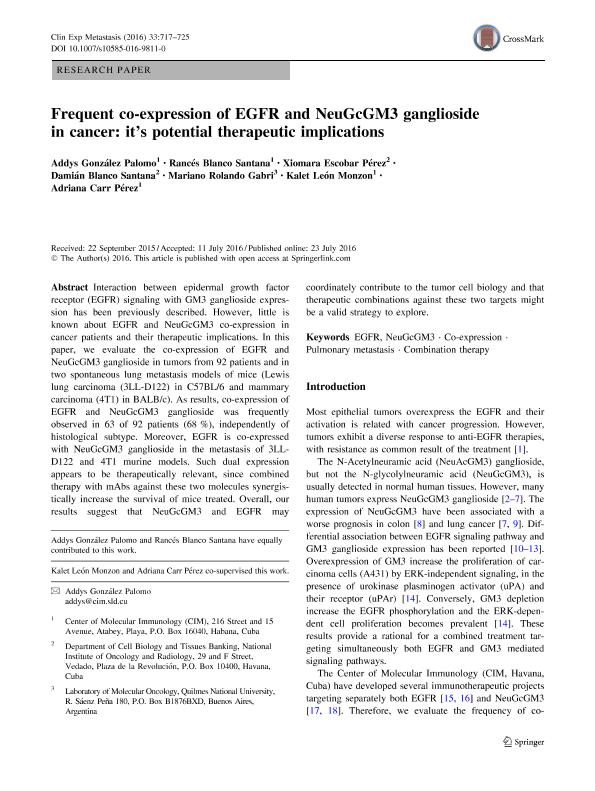Artículo
Frequent co-expression of EGFR and NeuGcGM3 ganglioside in cancer: it’s potential therapeutic implications
Palomo, Addys González; Santana, Rancés Blanco; Pérez, Xiomara Escobar; Santana, Damián Blanco; Gabri, Mariano Rolando ; Monzon, Kalet León; Pérez, Adriana Carr
; Monzon, Kalet León; Pérez, Adriana Carr
 ; Monzon, Kalet León; Pérez, Adriana Carr
; Monzon, Kalet León; Pérez, Adriana Carr
Fecha de publicación:
10/2016
Editorial:
Springer
Revista:
Clinical & Experimental Metastasis
ISSN:
0262-0898
Idioma:
Inglés
Tipo de recurso:
Artículo publicado
Clasificación temática:
Resumen
Interaction between epidermal growth factor receptor (EGFR) signaling with GM3 ganglioside expression has been previously described. However, little is known about EGFR and NeuGcGM3 co-expression in cancer patients and their therapeutic implications. In this paper, we evaluate the co-expression of EGFR and NeuGcGM3 ganglioside in tumors from 92 patients and in two spontaneous lung metastasis models of mice (Lewis lung carcinoma (3LL-D122) in C57BL/6 and mammary carcinoma (4T1) in BALB/c). As results, co-expression of EGFR and NeuGcGM3 ganglioside was frequently observed in 63 of 92 patients (68 %), independently of histological subtype. Moreover, EGFR is co-expressed with NeuGcGM3 ganglioside in the metastasis of 3LL-D122 and 4T1 murine models. Such dual expression appears to be therapeutically relevant, since combined therapy with mAbs against these two molecules synergistically increase the survival of mice treated. Overall, our results suggest that NeuGcGM3 and EGFR may coordinately contribute to the tumor cell biology and that therapeutic combinations against these two targets might be a valid strategy to explore.
Palabras clave:
Co-expression
,
Combination therapy
,
EGFR
,
NeuGcGM3
,
Pulmonary metastasis
Archivos asociados
Licencia
Identificadores
Colecciones
Articulos(SEDE CENTRAL)
Articulos de SEDE CENTRAL
Articulos de SEDE CENTRAL
Citación
Palomo, Addys González; Santana, Rancés Blanco; Pérez, Xiomara Escobar; Santana, Damián Blanco; Gabri, Mariano Rolando; et al.; Frequent co-expression of EGFR and NeuGcGM3 ganglioside in cancer: it’s potential therapeutic implications; Springer; Clinical & Experimental Metastasis; 33; 7; 10-2016; 717-725
Compartir
Altmétricas



